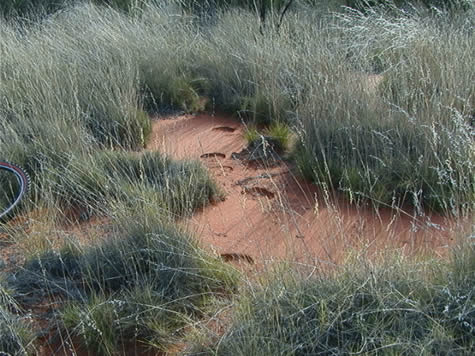Today we met with a new nemesis: spinifex. Spinifex is
a hardy grass, adapted to the poorest, driest, and
least nutritious soils in Australia. It’s the single
most common type of vegetation in Australia, covering
almost one-fourth of the entire continent!

There are thirty different species of spinifex, but
all share a common characteristic: they grow as close
clumps of blades, fanning out into all directions and
forming a hemispherical “hummock.” The roots grow in
two directions, first horizontally away from the plant
and then vertically down, in order to reach both
surface rainwater and deeper ground water. The heart
of a spinifex clump makes good shelter for snakes,
lizards, and small mammals. Even when the temperature
outside climbs to forty degrees Celsius, the heart
stays cool and is an excellent place for wildlife to
escape the heat.
As a young grass, spinifex has flat leaves. During
this time, when pores (also called stomates) in the
leaves release drops of water, the harsh sun quickly
causes the water to evaporate. During its first dry
season, however, spinifex leaves curl inward, creating
a hollow tube. This shape keeps the water droplets
from evaporating. These hollow rods are needle-sharp
and very strong, thanks to the presence of silicon
granules (called phytoliths) in their outer skin. A
grazing animal (or uncoordinated Expedition biker)
learns quickly to steer clear of these plants, or risk
having its skin punctured. The type of spinifex we’ve
run into today is the Weeping Spinifex, undoubtedly
named not only for its shape, but also for its effect
on its victims!
Git